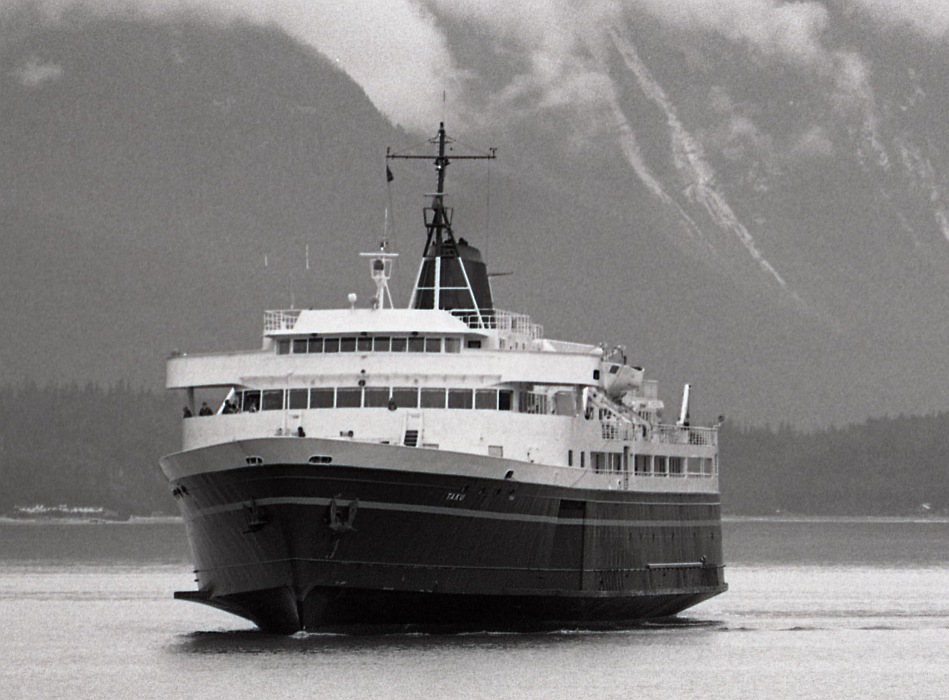
“I also answer to ‘Shannon’s sister’ when I’m in Sitka,” said Haugland, referring to long-time Daily Sentinel reporter Shannon Haugland. (KCAW photo/Robert Woolsey)
The state of Alaska gets a 133-percent return on its investment in the marine highway system.
That’s the conclusion of a recent economic analysis by the McDowell Group, and independent research firm based in Juneau.
Senior analyst Heather Haugland delivered the report for the first time to the Sitka Chamber of Commerce.
Listen to Heather Haugland’s chamber presentation in its entirety here.
Read the McDowell Group report on the Economic Impact of the Marine Highway System here.
The report was commissioned by the Marine Highway in 2014, but it’s driven entirely by statistics.
And some of the numbers are pretty granular. There’s not a lot Heather Haugland doesn’t know about passengers who, say, boarded a ferry in Sitka in 2014.
“You’ve got 81 Australians. 22 Germans, 16 New Zealanders. You had 2 people from the United Arab Emirates — I love this stuff, I think it’s so fascinating. 3 South Africans, and 89 Canadians. This data set — it’s so fun, obviously, to poke around in this data set and see where your people are coming from.”
But Haugland, who now lives in Bellingham after spending 12 years working for McDowell in Juneau, dives much deeper into the numbers. She tracks employment in the system, and where that money is being spent. She also tracks visitor traffic, and where passengers are headed when they ride the ferry.
It’s probably not where you were thinking.
“Anchorage and Juneau are the top two destinations. So folks taking the ferry are not just tooling around in Southeast. They’re driving, getting off the ferry in Haines or Skagway, or taking it up to the Southwest system. But they are getting throughout the state. Denali is the number 5 community of those visited. Fairbanks is number 7. Tok. These are communities that are not on the ferry system, but are benefitting from the service by getting visitors.”
And the ferry is not just for visitors. The other prize Anchorage and Juneau win is for travel by local residents. Juneau tops that list, followed by Anchorage. Ketchikan is a distant third, followed by Palmer and Wasilla.
Yup. There are more people from Palmer and Wasilla using the ferry than from Sitka. Than from Haines, even. And there are more residents of Fairbanks using the ferry than residents of Wrangell and Petersburg.
In just the last three years, traveling by Sitka on the ferry has become almost as rare as departing Chicago in a pullman sleeper car.
“Sitka’s traffic, between 2012 and 2015 has gone down by 33-percent. That’s about twice what the statewide traffic went down. I know that scheduling, and what’s going on with the ferries and their maintenance plays a role. But that’s a big number. I was surprised that it had gone down by a full third.”
Haugland is not sure how the information will be used by decision-makers in Juneau. The impression created by Sitka’s legislators — especially Sen. Bert Stedman — is that ferries are considered expensive and inefficient by railbelt politicians who prefer spending money on pavement.
Her biggest reveal, however, was pure economics. In 2014, the state funded ferries to the tune of $117-million. The net economic benefit to the state was $273-million — a return of 133-percent.
Nevertheless, state support for the marine highway continues to decline.
“There was a $123-million subsidy in 2013. And what they’re talking about in the house and senate — juggling around right now — it may be about $84-million going forward, for fiscal year 2018.”
Haugland lets the numbers speak for themselves, and resists the impulse to interpret them.
When a chamber member asked her for suggestions on how to stop the decline in passenger traffic out of Sitka she replied, “That’s a question for the marine highway.”































